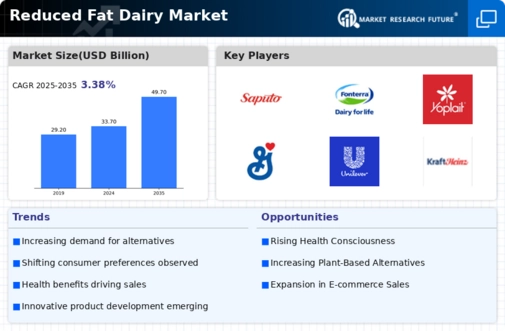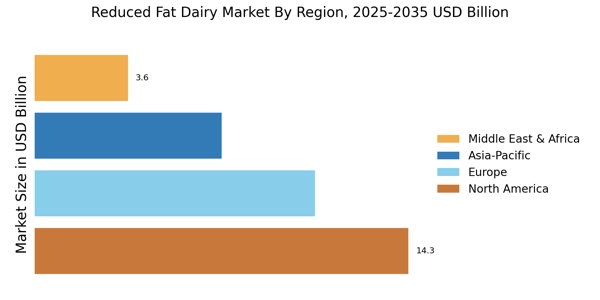Changing Dietary Preferences
Evolving dietary trends, particularly the shift towards plant-based and lower-fat diets, are influencing the Reduced Fat Dairy Market. As more consumers adopt diets that emphasize reduced fat intake, the demand for reduced fat dairy products is expected to rise. This trend is further supported by dietary guidelines that recommend lower saturated fat consumption. The market data suggests that reduced fat milk and yogurt are among the fastest-growing segments within the dairy category, indicating a clear consumer preference for these options. The Reduced Fat Dairy Market is poised to capitalize on this shift, as it aligns with broader health and wellness trends.
Health Awareness and Nutrition
The increasing awareness regarding health and nutrition among consumers appears to be a primary driver for the Reduced Fat Dairy Market. As individuals become more conscious of their dietary choices, the demand for reduced fat dairy products has surged. According to recent data, the market for reduced fat dairy products is projected to grow at a compound annual growth rate of approximately 5.2% over the next five years. This trend indicates a shift towards healthier alternatives, as consumers seek to lower their fat intake while still enjoying dairy products. The Reduced Fat Dairy Market is likely to benefit from this heightened focus on health, as more individuals opt for options that align with their wellness goals.
Product Innovation and Variety
Innovation in product formulation is a significant driver within the Reduced Fat Dairy Market. Manufacturers are increasingly introducing a diverse range of reduced fat dairy products, including yogurt, cheese, and milk, that cater to varying consumer preferences. This innovation not only enhances the appeal of reduced fat options but also addresses the demand for flavor and texture. For instance, the introduction of flavored reduced fat yogurts has attracted a younger demographic, thereby expanding the consumer base. The Reduced Fat Dairy Market is likely to see continued growth as companies invest in research and development to create new and exciting products that meet the evolving tastes of consumers.
Consumer Education and Marketing Efforts
Effective marketing strategies and consumer education initiatives are vital drivers for the Reduced Fat Dairy Market. Companies are increasingly investing in campaigns that highlight the benefits of reduced fat dairy products, emphasizing their nutritional value and health advantages. Educational programs aimed at informing consumers about the importance of incorporating reduced fat options into their diets are also gaining traction. This focus on consumer education appears to be yielding positive results, as awareness of the benefits of reduced fat dairy continues to grow. The Reduced Fat Dairy Market is likely to thrive as these efforts resonate with health-conscious consumers seeking informed choices.
Increased Availability and Accessibility
The expansion of distribution channels is a crucial driver for the Reduced Fat Dairy Market. Retailers are increasingly stocking a wider variety of reduced fat dairy products, making them more accessible to consumers. This increased availability is particularly evident in supermarkets and health food stores, where dedicated sections for reduced fat options are becoming commonplace. Additionally, online grocery shopping has further enhanced accessibility, allowing consumers to easily find and purchase their preferred reduced fat dairy products. The Reduced Fat Dairy Market is likely to experience growth as a result of this enhanced distribution, catering to the needs of health-conscious consumers seeking convenient options.


















Leave a Comment